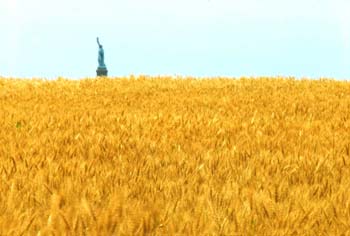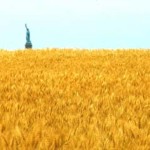By MARGOT ANNE KELLEY
You heard it here first: Al Gore won! Okay, so maybe you aren't hearing it here first (and maybe you no longer believe it when you hear it, anyway). But this month, Gore was awarded the Nobel Peace Prize in recognition of his efforts to call attention to global climate change. He shared this award with the Intergovernmental Panel on Climate Change (IPCC), a group which released a series of reports on global warming over the past year. Few are publicly criticizing the choice of the IPCC for this recognition; however, it will come as little surprise that the selection of Al Gore for the honor is generating controversy. Critics complain not only that others have done more for world peace this year than Gore has, but also that his claims about global warming and planetary troubles are hyperbolic. Supporters point out that since the arrival of An Inconvenient Truth, the discourse regarding climate change has, itself, undergone a sea-change. No longer are we arguing about whether humans are effecting the environment; instead, we're asking how much are we impacting it? What can we do? What should we do?
The world press has proffered plenty of speculations about the significance of giving Gore this accolade. The one that sends artistico-philosophical chills up my spine (in a good way, mind you) is that Gore has been honored not just for the content of his arguments but for the fact that he fundamentally re-shaped the kinds of conversations about a critical issue that we are able to have. Yup, this time you really are hearing it here first: Gore's getting a Peace Prize for doing what artists routinely do.
This thought keeps recurring as I imagine what might happen at Grounding Work, the weekend-long symposium on art and the environment that's going to be held at the Massachusetts College of Art + Design (a.k.a. Mass Art) from 9-11 November. Showcasing visual, sound, virtual, literary, and installation work by approximately twenty artists who have taken environmental matters to heart, the symposium is bound to generate not just awareness of environmental art, but also some very changed conversations. The artists who will be participating make work that runs a gamut from delicate, solitary interactions with the physical world to massive, widely collaborative creations. Martin Prothero, for instance, makes carbon prints on glass plates by leaving them in places he knows animals will tread. Quietly sitting in various natural locales for hours on end, discovering the best places to site the plates, is as much a part of his artwork as are the trace-laden images that result. In sharp contrast are the works of conceptual and environmental art pioneer Agnes Denes, who will be giving the keynote address on Saturday, November 10. Denes is best known for projects like "Wheatfield—A Confrontation" (1982) in which she and a team of volunteers transformed a trash-strewn site in Manhattan into a 1.8 acre wheatfield, which they cultivated for a season and then harvested. Such work depends upon scores of participants—from city permitting officials, to assistants who helped sow the wheat, to the thousands of passers-by who observed its growth, to the NYPD's horses who ultimately ate the hay that had been raised. In thus extending the network of those involved, Denes created an eco-system within and about the eco-system(s) she was ostensibly exploring.
Because of the range of media and message that the Grounding Work participants offer through their work, the symposium promises something extra, something in addition to bringing together environmentally engaged artworks and artists; its structure tacitly asks what it is we mean when we say something is "environmental art" in an era when we know that human actions, large and small, contribute to climate change.
As environmental art emerged in the 1960 and ‘70s, it was dominated by site-specific works that had the dual capacity of critiquing existing art spaces and practices while also offering a new vision of the interpenetration of art into/with a natural context. Not all outdoor work, of course, was regarded as environmental art; makers and critics agreed that, in addition to engaging the natural world, environmental art works should "do no harm." Increasingly, this attribute complicates our conversations. For me, nowhere is the ambivalence about whether we can/should/must make work that does no harm more clear than in one of the pieces scheduled to appear at Grounding Work, a video document by performance artist Patrick Mulligan entitled "Walden" (2006).
Some of the artists whose work will be featured have carried the mandate to "do no harm" further, have involved themselves in remediation efforts that redress problems—as does Jackie Brookner, for instance, with her "biosculptures." These site-specific works incorporate plants that can filter water, thus aesthetically and literally addressing issues of water quality. Such efforts raise special challenges: how—and how viably—can artists work with remediation engineers to effect change? Is it "better" in some sense to effect smaller improvements that are more visually apparent (and thus more likely to raise awareness) or to effect larger changes that are not readily apparent to an audience, but of greater benefit to the ecosystem? On which leg, that is, does an environmental artist put the balance of her weight—on the environmental or the artist?
I doubt anyone at the symposium expects to arrive at a single answer to that last question, but the roundtable discussion scheduled for Sunday, November 11th is certain to explore it. Brookner will be joined in that conversation by an environmental engineer who designs remediation projects, a city planner who evaluates requests for land use permits, and a public arts commissioner. Together, they'll address some of the challenges faced by artists who want to make physically durable artworks in public settings.
For environmental and conceptual artists alike, the problems associated with the "physically durable" work have been a concern for decades. Sound artists like John Holland and writers like Allison Wallace are, by virtue of their media, able to make evocative work while side-stepping many (albeit not all) of the vexing environmental problems that making objects can raise. But what of the photographers and painters whose work is on exhibit in the Godine Family Gallery as part of the symposium? Lisa Martin and Christine Collins, both of whom are exploring organic and sustainable farming in their recent projects, have bemoaned the dilemma their medium makes unavoidable: processing film and making photographic prints both release toxins into the environment, and divert gallons of potable water from other uses. Martin and Collins don't ignore this problem, but instead continue to seek a reasonable balance between the demands of art and planet.
Permutations on that precarious balance will, I suspect, be the persistent subtext of the symposium. As folks fly and drive to Boston for the weekend to share work (and we locals escape November's chill in the overly-heated old building), as we talk about the projects we've undertaken all over the globe, as we sip wine out of disposable plastic glasses during an opening that celebrates environmental artworks, or grab a single-serving bottle of water between sessions devoted to the work of individual artists, we will—with luck and thoughtfulness—move past simplistic senses of the struggles we all face and toward more complex conversations.
- Agnes Denes, Wheatfield – A Confrontation, Battery Park Landfill, NY, 1982
- Martin Prothero, Carbon Light Life (PIGEON Columba livia), carbon on glass
Grounding Work: A Symposium on Art and the Environment is free and all are welcome. However, because of space limitations, pre-registration is required. You may sign up to come to one, two, or all three days of events. Please visit the website atwww.groundingwork.org, check out the schedule, and register.
All images are courtesy of the artist and Grounding Work.






